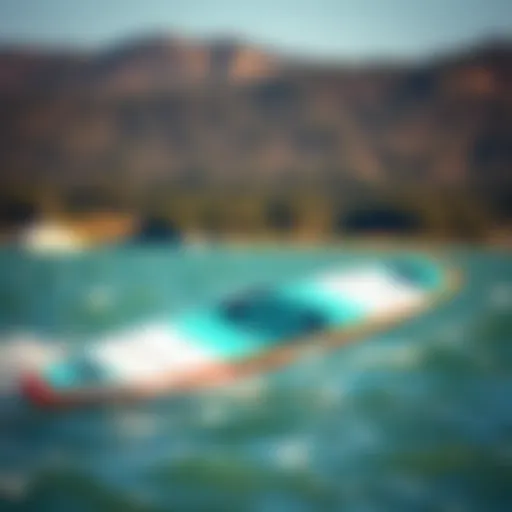Winter Wet Suits: Gear for Cold Kiteboarding
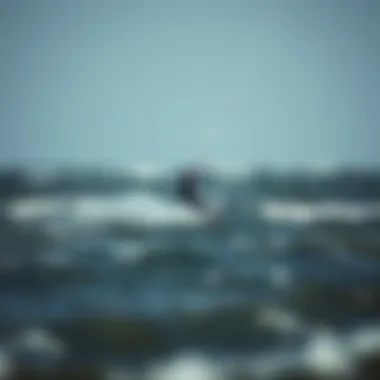
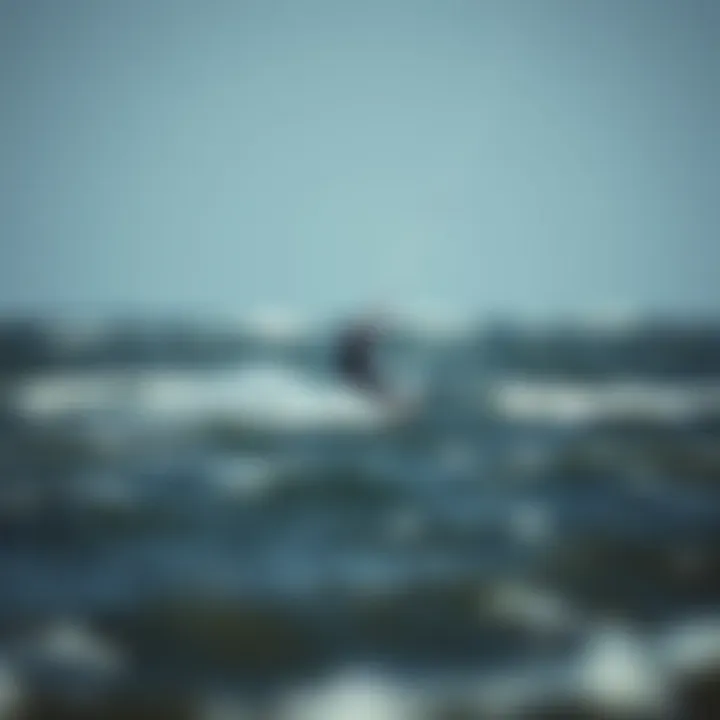
Intro
As the days grow shorter and the temperatures plummet, the allure of kiteboarding can still beckon adventurous spirits. However, kiteboarding in the cold demands specialized gear—most notably, a high-quality winter wet suit. This article dives deep into the world of winter wet suits, showcasing how these vital pieces of equipment can transform your cold-weather kiteboarding experience from daunting to exhilarating. We’ll explore the latest advancements in wet suit technology, discuss materials that offer both warmth and flexibility, and highlight key considerations that can make or break your time on the water.
The right wet suit doesn't just keep you warm; it can enhance your overall performance, allowing you to stay out longer, ride harder, and enjoy the thrill of the sport, even when icy winds whip through the air. Additionally, we recognize that kiteboarding enthusiasts range from absolute beginners to seasoned pros, so every bit of information provided is tailored to cater to your specific needs and aspirations.
In the following sections, we’ll break down the essential features to look for in a winter wet suit, review some of the latest offerings on the market, and provide actionable tips to ensure you are ready to take on the cold. Through careful analysis and expert insights, our goal is to empower you with the knowledge you need to make informed decisions and maximize your kiteboarding adventures during the colder months.
Gear Insights
The Importance of Choosing the Right Wet Suit
A wet suit is much more than just an article of clothing; it�’s your first line of defense against the elements. Especially when kiteboarding in chilly waters, the comfort and functionality provided by a good wet suit can dictate your performance and enjoyment. Key features to pay attention to include:
- Material: Neoprene is common due to its insulating properties, but thickness varies. Consider thickness that suits the water temperature where you will be kiteboarding.
- Fit: A snug fit is essential; water should not pool inside the suit, which could lead to a drop in temperature. Look for suits that are designed to fit your body type.
- Flexibility and Mobility: Rigid suits can inhibit movement, making it difficult to maneuver while riding. Optimal suits incorporate advanced materials that allow for a full range of motion.
Latest Gear Reviews
When it comes to selecting the right gear, staying updated with the latest offerings can keep you ahead of the game. Some noteworthy winter wet suits for kiteboarding to invest in this season include:
- O'Neill Psycho Tech: Known for its impressive flexibility and thermal insulation, this suit combines a comfortable fit with cutting-edge materials.
- Rip Curl Dawn Patrol: For those who might be on a budget, this model delivers decent warmth and flexibility without breaking the bank.
- Xcel Drylock: This suit features some of the best water sealing technology, keeping you warmer and drier even in the most frigid conditions.
Essential Gear for Beginners
If you’re just dipping your toes into the world of kiteboarding during winter, selecting the right gear is crucial for both safety and enjoyment. For beginners, consider starting with:
- A mid-range wet suit: It should provide a good mix of warmth and flexibility that won't require you to take a second mortgage.
- Protective gear: Including a helmet and impact vest can offer additional safety against the cold and accidental impacts.
- Kiteboarding lessons: Look for instructors that cater to beginner levels; they can provide delta tips on both gear and handling the kite.
"A great winter wet suit can make the difference between a memorable session on the water and an out-in-the-cold experience you’d rather forget."
Winter doesn’t have to signal the end of your kiteboarding adventures. Equip yourself with the right wet suit and gear, and you can embrace the chill with confidence.
Prologue to Winter Wet Suits
When it comes to kiteboarding in the colder months, winter wet suits are the unsung heroes behind the scenes. They play a pivotal role in keeping enthusiasts safe and comfortable while they ride the waves even when frost hangs in the air. For kiteboarders, the ability to maintain body heat when submerged in chilly waters can be the fine line between an exhilarating session or a frigid disaster.
A wet suit, specifically designed for winter, isn’t just a piece of clothing; it's a necessary tool. These suits are crafted with advanced materials and technologies that work together to insulate against the cold, allowing riders to prolong their sessions without feeling like they are slowly turning into ice pops. The significance of a well-fitted, high-quality winter wet suit cannot be overstated – it is what draws the line between enjoying an adrenalin-pumping experience and cutting a session short due to discomfort.
Even if you think getting a wet suit is as simple as picking out something that looks good, there are several critical factors to consider. The thickness, flexibility, and type of insulation can drastically affect comfort and performance. As temperatures drop, it’s the technical features of a wet suit that become paramount.
The main benefits of investing in an appropriate winter wet suit include:
- Thermal protection: Keeps the body warm, ensuring that hypothermia is kept at bay.
- Improved endurance: By staying warm and mobile, kiteboarders can ride longer, enhancing their overall experience.
- Protection from the elements: Wet suits also protect against wind chill and irritation from water.
- Increased confidence: Knowing that you’re well-protected can empower you to tackle more challenging conditions.
In summary, winter wet suits do far more than cover the body; they serve as essential gear that enhances both safety and performance in cold conditions. With the right suit, kiteboarders not only shield themselves from the biting cold but also unlock new potential within themselves to conquer the winter seas. This article will explore everything you need to know about selecting the best winter wet suit and its key features, ensuring that every kite session is one filled with fun and safety.
Importance of Proper Gear in Kiteboarding
When it comes to kiteboarding, especially in the winter months, wearing the right gear is not just a matter of comfort—it's essential for safety and performance. Kiteboarding exposes riders to frigid air and water, and being inadequately dressed can lead to hypothermia or other cold-related injuries. Understanding this importance aids in making informed decisions about your gear, ensuring that you can enjoy the thrill of riding without compromising your well-being.
Understanding Temperature Conditions
Temperature plays a significant role in how a kiteboarder experiences their session. Cold air and water can sap your body heat quickly, making it vital to maintain core warmth. Generally, the water temperature is often lower than the air temperature, and while a bright sunny day may seem inviting, it can be deceiving. For instance, even if the sun is shining, water temperatures can plummet, necessitating proper insulation provided by winter wet suits.
Wet suits are designed to create a thin layer of water between your skin and the suit material. The body then warms this layer of water, offering insulation. The suit's insulating capabilities, along with its thickness, are crucial. It’s recommended to pay close attention to temperature guidelines offered by various associations. As a general rule, when water temperatures drop below 60°F (15°C), riders should strongly consider using a winter wet suit.
*"The real kicker? Your body loses heat 25 times faster in water than in air."
With this in mind, understanding regional climates and making decisions based on your local water conditions ensures you’re properly prepared. What feels mild on land can turn into a bone-chilling reality once you're submerged.
How Gear Affects Performance


Kiteboarding is about more than just the fun factor; it demands focus and agility. The right gear significantly influences performance capabilities. A stiff, ill-fitting wet suit not only restricts mobility but can also lead to fatigue faster than you can say "kiteboard!" Flexibility is paramount. A winter wet suit that provides optimal flexibility and range of motion allows for better control of the board and the kite. Riders can maneuver, jump, and even land tricks while staying warm, ultimately leading to an enhanced overall performance experience.
Moreover, the design and materials used impact not just warmth but also buoyancy and drag. A good wet suit minimizes water entry, reducing drag, which is vital for smooth sailing. Furthermore, advanced waterproofing technology ensures that the suit remains effective even in choppy conditions, allowing for longer sessions without the chill.
In summary, kiteboarding in cold conditions is exhilarating but requires due diligence regarding gear selection. The correlation between the temperature conditions and gear performance is undeniable. Paying close attention to the type of wet suit you choose can mean the difference between a fun winter session and a shivering retreat to the shore.
Ultimately, the best advice is to invest in high-quality winter wet suits tailored for specific conditions to enrich your kiteboarding adventures.
Key Features of Winter Wet Suits
When it comes to kiteboarding in the chilly embrace of winter, having a proper wet suit isn't just a matter of comfort—it's a game changer. The key features of winter wet suits play a substantial role in ensuring both performance and protection. These suits are designed to tackle the unique challenges posed by cold water, providing not only warmth but also the flexibility necessary for agile maneuvers on the kiteboard. Let's delve deeper into these crucial features.
Insulation and Warmth
One of the standout features of a winter wet suit is its insulation properties. The design focuses on trapping body heat while preventing it from escaping too quickly. High-quality suits commonly utilize materials like neoprene, which retains heat effectively. A well-insulated wet suit allows kiteboarders to enjoy extended sessions without succumbing to the biting cold of winter waters.
"In frigid conditions, a wet suit acts as your second skin by not just keeping you warm, but also aiding your performance by allowing for better blood circulation."
Most people don’t realize that there is a significant difference between standard suits and those made specifically for winter use. The thickness of the neoprene plays a crucial part; typically, winter suits range from 4mm to 6mm in thickness, with some advanced models reaching up to 7mm for extreme conditions. This extra thickness helps maintain body temperature even when submerged in icy waters.
Flexibility and Mobility
A common misconception is that thicker suits stifle mobility. However, modern designs challenge that notion. Key manufacturers have focused on creating suits that offer remarkable flexibility without sacrificing warmth. Innovations like panels of thinner neoprene strategically placed around joints allow for unencumbered movement when steering your kite or performing tricks.
When choosing a wet suit, pay close attention to how well it fits. A snug fit ensures zero water entry, which is vital for maintaining warmth. Suits that promote ease of movement can contribute to a kiteboarder’s performance significantly. Consider trying on different models; feel whether you can comfortably reach, stretch, and twist as needed.
Waterproofing Technology
Waterproofing is another essential feature when we talk about winter wet suits. The ability to keep water out is crucial, especially for kiteboarding where splashes and submersion are part of the experience. The best suits employ advanced waterproofing technology that can make a world of difference.
Sealing techniques vary from suit to suit, but you’ll often find options like liquid seam sealing or taped seams that drastically reduce water entry. These features not only help keep you dry but also add to the overall durability of the suit. It’s a crucial point to consider if you're planning on riding in conditions where falling into the water is inevitable.
Materials Used in Winter Wet Suits
Selecting a winter wet suit is about much more than just picking the latest style; it’s about understanding the materials that make these suits work effectively in cold water. The choice of material directly influences warmth, flexibility, and durability—all critical factors when kiteboarding during winter. Let's dive into the two main categories of materials found in winter wet suits, namely neoprene and alternative options.
Neoprene: The Standard Choice
Neoprene is the reigning champion when it comes to wet suit materials. It's a synthetic rubber that provides excellent insulation without compromising too much on flexibility, which you really need when you’re out there on the water.
- Insulation: Neoprene effectively traps a thin layer of water against your skin, which your body warms up, creating an insulating barrier. This helps to keep your core temperature stable in frigid conditions. Whether you're riding the waves or simply getting back on your board after a wipeout, neoprene keeps you warmer than you'd expect.
- Flexibility: Another attribute of neoprene is its considerable stretchiness. This is vital for kiteboarding as it allows for freedom of movement. A stiff suit makes for a lousy experience and can hinder your performance. The most popular types of neoprene are 3mm, 4mm, and even 5mm thicknesses, tailored for varying winter temperatures.
- Durability: When kiteboarding, your gear takes a beating. Neoprene is generally abrasion-resistant, so it holds up against elements like rocks, sand, and even your own sharp kite lines.
Despite its many advantages, neoprene does have its limitations. For instance, it can retain water, which might lead to feeling slightly weighed down. Some kits also have an odor after prolonged use, which might be a turn-off for some.
Alternative Materials
While neoprene may be the most recognized option for wet suits, there are alternative materials that catering to specific needs. These can bring different benefits and drawbacks.
- Yulex: A new contender in the eco-friendly arena, Yulex is made from natural rubber derived from the guayule plant. It may not have the same flexibility as neoprene but offers a nice ecological benefit for environmentally-conscious riders. Plus, it provides decent insulation with a slightly softer feel.
- Polyester and Nylon Blends: Some suits feature a mix of polyester or nylon in their construction. These materials can be lighter and often dry quicker than traditional neoprene. However, you might sacrifice some insulative quality, especially in colder climates.
- Hollow Fiber Technology: A technology emerging in some modern suits involves hollow fibers that trap heat while maintaining breathability. This material is still not as commonplace as neoprene but is slowly finding its niche.
"Choosing the right material can mean the difference between a comfortable ride and a freezing, miserable outing."
Ultimately, the decision boils down to personal preference and individual requirements for kiteboarding. Whether you stick with the reliable neoprene or gamble on a more innovative material is up to you, but being informed helps in making the best choice for your winter adventures.
Selecting the Right Winter Wet Suit
Choosing an appropriate winter wet suit is crucial for kiteboarders who want to enjoy their time on the water even in chilly conditions. A well-fitted and functional wet suit not only ensures comfort but also impacts safety and performance on the water. With varying temperatures and conditions, making the right selection can mean the difference between a memorable session and an uncomfortable experience.
Sizing Considerations
When selecting a wet suit, the first step is ensuring that you get the right size. A suit that is too tight can restrict movement and circulation, hindering your ability to maneuver while kiteboarding. On the flip side, a suit that is too loose can allow water to seep in, making it difficult to maintain warmth. Here are a few tips to consider for sizing:
- Measure Yourself: Use a soft measuring tape to determine your chest, waist, and hip dimensions. Match these figures against the size charts provided by manufacturers. Different brands may have slightly varied sizing, so it’s worth checking each time.
- Try it On: If possible, try on the wet suit at a local shop. You want to ensure that the suit feels snug but not constricting. Flexing and stretching while you’re trying it will give an idea of how it moves with your body.
- Check the Legs and Arms: The legs and arms should end just above the wrists and ankles, respectively. Any extra length can bog you down or interfere with your kiteboarding gear.
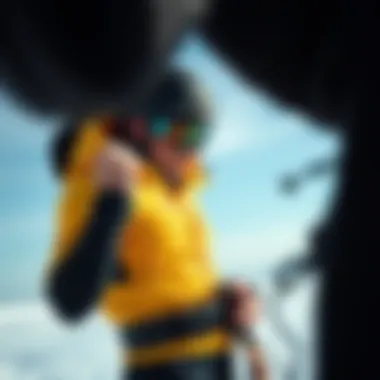
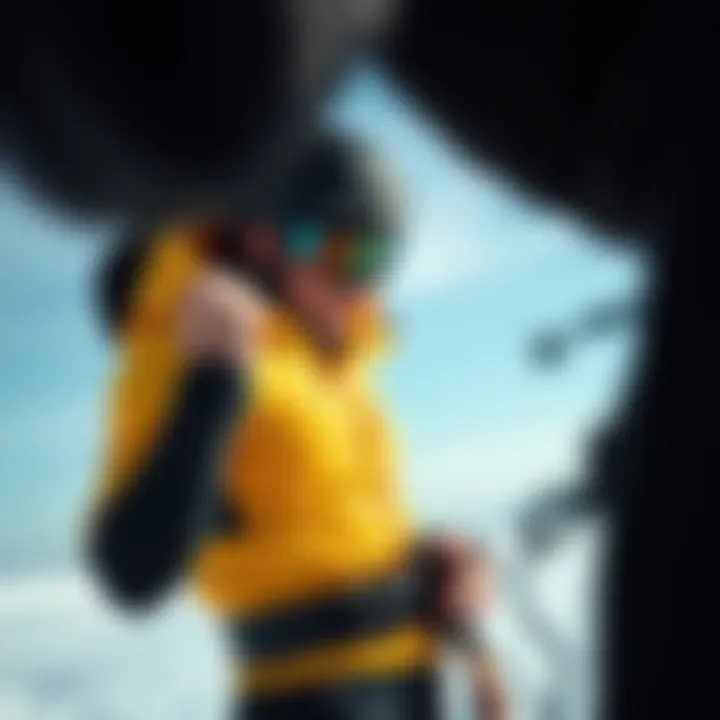
Finding the right fit is not just about comfort; it’s about enhancing your performance. When you feel good in your gear, you can focus your energy on enjoying the ride.
Thickness Ratings Explained
The thickness of a wet suit is another essential consideration. Wet suits come in varying thicknesses, typically measured in millimeters. This rating impacts the suit's insulation capabilities which is vital during those colder months. Here’s what you should know about thickness ratings:
- Common Thickness Ratings: Most winter wet suits fall between 3mm to 6mm. A 3mm suit offers flexibility but may not provide enough warmth in extremely cold waters. In contrast, a 6mm suit allows for greater insulation but can be more restrictive in terms of movement.
- Layering Options: Some kiteboarders choose to combine a thinner suit with additional thermal layers. This method can offer flexibility while still keeping you warm.
- Water Temperature Guidelines: A general guideline for thickness is as follows:
- 1.0mm to 2.0mm: Suitable for water temperatures above 75°F.
- 3.0mm: Best for water temperatures around 65°F to 75°F.
- 4.0mm to 5.0mm: Ideal for water temperatures about 55°F to 65°F.
- 6.0mm and above: Used for temperatures below 55°F.
A suited fit and the correct thickness not only insulate your body but also contribute to your overall experience in the water. Kiteboarding in cold weather should be enjoyable, and having the right gear is a critical part of that.
As you navigate your choice, remember how each component—fit and thickness—plays a role in either enhancing or detracting from your kiteboarding experience during winter.
Additional Features to Consider
When kitesurfing in cold conditions, choosing a wet suit is not merely about insulation. Each component can greatly affect your comfort, safety, and overall enjoyment on the water. Two significant aspects that riders often overlook are zipper types and seam techniques. Each element can make or break your experience, particularly when temperatures dip and conditions become harsher.
Zipper Types and Locations
The zipper on a wet suit plays a crucial role in functionality and wearability. There are various types of zippers you might come across, and understanding these can provide a significant advantage.
- Back Zipper: This is the traditional style most people are familiar with. The zipper runs down the back. While it offers ease of entry, it can sometimes let in water if not sealed properly.
- Chest Zipper: A more modern design that allows for less water entry. It can be slightly trickier to get in and out of but is fantastic for maintaining warmth.
- No Zip: These suits have no zippers at all. They can be a bit of a challenge to put on with a snug fit but excel in terms of thermal protection since they're completely sealed.
The location of the zipper also matters. A high position makes it easier to secure the wet suit tighter for better insulation. It’s essential to pick a suit that allows for comfortable movement while still adhering closely to your body. A zipper that is well placed can also contribute to reducing chafing during long sessions on the water.
Seams and Stitching Techniques
The seams on a wet suit do more than just hold the fabric together; they are the critical line of defense against water ingress. Different stitching techniques can dictate how effectively a wet suit keeps water out.
- Flatlock Seams: This method lays the fabric edges flat and stitches them together. While it is durable, this technique can allow a bit of water to seep in due to its less tight fit.
- Blind Stitch Seams: A step up from flatlock seams, the needle does not penetrate the entire fabric, so they are less water permeable. This type offers a good balance between flexibility and durability.
- Glued and Blind Stitched: Consider this the heavyweight champion of wet suit seams. This method involves gluing the fabric edges and then blind stitching them. It offers superior strength and excellent watertightness, making it a favorite for winter conditions.
In terms of choosing a wet suit, the seam type can dramatically affect your comfort. If you’re going to spend hours in chilly waters, the last thing you want is for a seam to create irritation or for water to seep in and chill you to the bone.
Ensure you familiarize yourself with these features, as they are pivotal for anyone enthusiastic about kiteboarding in cold weather conditions. By carefully considering these elements, you can enhance your experience and ensure every session is as pleasurable as possible.
Caring for Your Winter Wet Suit
Taking care of your winter wet suit is crucial for kiteboarders who want to extend the life of this essential gear. Not only does proper care enhance the durability of the suit, it also ensures that you remain comfortable and safe in cold water conditions. A well-maintained wet suit will offer optimal insulation and flexibility, which is vital as those winter months roll in. Here’s a closer look at how you can keep your wet suit in top shape.
Proper Cleaning Techniques
Cleaning your wet suit might seem like a simple task, but it’s vital to do it correctly to avoid damaging the fabric and maintaining its water resistance. After each use, especially in saltwater, it helps to rinse your suit thoroughly with fresh water. This helps remove salt and sand that can degrade the material over time.
When washing, avoid using harsh detergents or fabric softeners, as these can break down the neoprene and interfere with its insulation properties. Instead, consider using a specially formulated wetsuit cleaner that is designed to clean without damaging the material. It's best to soak the suit for a bit, gently rub away any grime, and then rinse it off with cold water.
Remember: A little care goes a long way!
Keep your wet suit clean and it will keep you warm and mobile while kiteboarding.
Drying and Storage Tips
Once you’ve cleaned your suit, how you dry and store it is just as important. Avoid direct sunlight, as UV rays can break down the neoprene material. Hang your wet suit upside down or lay it flat to dry in a shaded, airy spot. You can use a thick hanger to help maintain the shape of the shoulders but be careful not to stretch it out.
For long-term storage, ensure the suit is completely dry to prevent mold from forming. You can store your suit in a cool, dry place, ideally inside a breathable bag. Avoid folding it tightly as creases can weaken the material, leading to leaks when you are out kiting.
Key points for drying and storing your wet suit:
- Hang or lay flat to dry, avoiding direct sunlight.
- Ensure it's completely dry to prevent mold growth.
- Store in a breathable bag, avoiding tight folds.
By adhering to these care instructions, you not only enhance the longevity of your winter wet suit, but you also ensure that every kiteboarding session in cold conditions is a comfortable and enjoyable experience.
Recommended Brands and Models
Choosing the right winter wet suit can feel like navigating a maze, especially when options appear to be nearly limitless. Thus, knowing which brands and models stand out can enhance your kiteboarding experience and keep you warm in colder climates. Reliable gear can make the world of difference out on the water, both in terms of performance and comfort.
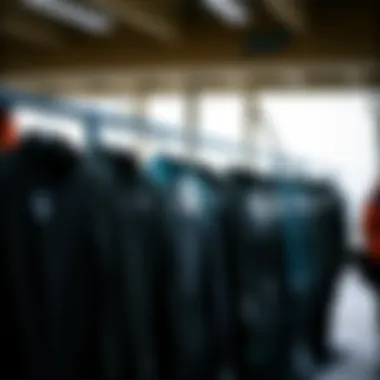
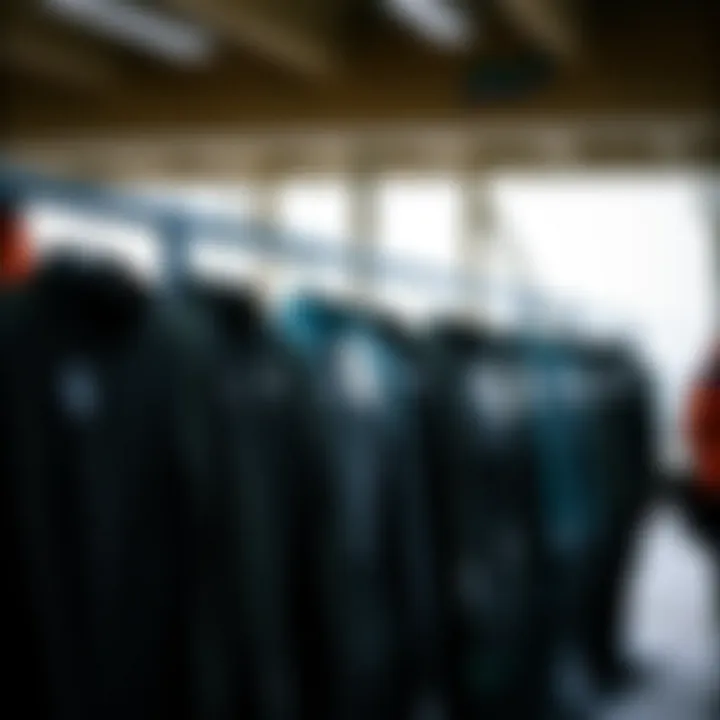
When discussing recommended brands and models, it's crucial to focus on a few specific elements: performance, fit, durability, and of course, budget. Some brands consistently deliver high-quality suits that cater to various needs, while others offer budget-friendly options without sacrificing too much in the way of performance.
High-Performance Options
For those chasing after the ultimate in kiteboarding performance during the winter months, O'Neill and Rip Curl are names that often come up. With a solid reputation among professionals, these brands offer suits like the O'Neill Psycho Tech and the Rip Curl Flashbomb, which deliver excellent insulation paired with remarkable flexibility.
Key features of these high-performance suits include:
- Super Elastic Neoprene: Enables unrestricted movement, essential for executing your maneuvers.
- Thermal Lining: Provides warmth without adding extra bulk, ensuring you won't feel weighed down.
- Seamless Construction: Reduces the chance of water seeping in, keeping you dry during your ride.
Such options not only keep the chill at bay; they also support your performance as you tackle those winter waves, ensuring you can still ride comfortably and confidently.
Budget-Friendly Choices
On the other side of the equation, there are brands like Maestro and Cressi that provide decent wet suits without requiring deep pockets. Models such as Maestro's Hydroflex and Cressi's Shorty make for solid alternatives. While they may lack some of the finesse found in higher-end models, they prove their worth for recreational kiteboarders.
When considering budget options, think about:
- Adequate Insulation: Even less expensive suits should offer reasonable warmth if you're braving the cold.
- Fit: Ensuring a snug fit is crucial to maintain warmth and performance, even in lower-cost models.
- Durability: Seek materials and stitching that can withstand the splashes and wear of the sport.
It’s wise to read reviews from fellow kiteboarders or consult resources like Reddit when looking for honest opinions on budget-friendly choices versus high-end performance gear.
"Investing in a suited wet suit pays off when the temperatures drop; performance won't suffer just because you’re being mindful of your budget."
Enhancing Your Kiteboarding Experience in Winter
Winter kiteboarding can be an exhilarating endeavor, but it brings its own challenges. One of the most important factors contributing to a rewarding experience on the freezing waters is how you prepare both your body and your gear, particularly with winter wet suits. Enhancing your kiteboarding experience in colder months hinges on considering specific elements that not only boost performance but also maintain comfort in those frigid temperatures.
When kiteboarding in winter, your focus should be on how to maximize warmth and mobility while ensuring safety. Proper layering, staying dry, and understanding the impact of frigid water on your body are critical. The last thing you want is to cut your session short due to the chill creeping in.
Here are some strategies to enhance your experience:
- Prioritize insulation: Start with a solid base layer that can wick moisture away from your skin. Combine that with a solid winter wet suit that provides adequate insulation while allowing for movement.
- Plan for wind chill: Keep in mind that wind can make the temperature feel much colder than it truly is. Select gear that enhances your warmth while cutting down wind exposure.
- Stay hydrated and nourished: Cold weather can desensitize your body’s signals. Hydration and proper nutrition are crucial for maintaining energy levels.
"Layering effectively not only guards you against the cold but also enables you to keep up the rhythm and focus when the wind is kicking up."
Taking these insights into account will significantly enhance your kiteboarding adventures in winter. Let's delve deeper into two pivotal aspects of this experience — layering techniques and staying safe in cold water.
Layering Techniques
Perfecting your layering strategy is vital when it comes to winter kiteboarding. The main idea is to manage your body heat while avoiding being weighed down or restricted. Here’s how to achieve an optimal layering system:
- Base Layer: Choose a form-fitting, moisture-wicking fabric that draws sweat away from the skin. Materials like merino wool or synthetic blends are ideal as they can provide warmth without bulk.
- Mid Layer: This layer should provide insulation. Fleece or thermal tops can serve this purpose well. Avoid bulky options that might hinder your mobility.
- Outer Layer: A good quality winter wet suit serves as an outer layer. Depending on the thickness, ensure it balances warmth and flexibility, letting you move comfortably while kiteboarding.
- Accessories: Don’t neglect the use of gloves, hoods, and booties designed for cold weather. Each has a role in preventing heat loss from your extremities, where the chill can be best felt.
Utilizing these layering techniques will not only keep you warm, but also help in maintaining agility, allowing you to enjoy your ride without discomfort.
Staying Safe in Cold Water
Safety becomes paramount when kiteboarding in cold conditions. The icy waters can pose serious risks, such as hypothermia or shock. Here are some points to consider:
- Know the Conditions: Always check the weather and water temperatures before heading out. Being informed will give you insight on how to prepare.
- Stay Within Your Limits: Be honest about your skill level. If you’re feeling uncertain due to the conditions, it might be best to stick to a more sheltered area.
- Buddy System: Go kiteboarding with a partner if you're on colder water. This not only makes the session more enjoyable but ensures help is available should an emergency arise.
- Practice Self-Rescue Techniques: Always have a plan for what to do in case you fall into cold water. Practice self-rescue techniques so that, in emergencies, you can react swiftly.
- Wear a Floatation Device: A personal flotation device can be a lifesaver. Ensure that it’s comfortable yet compliant with safety regulations.
By embracing these safety measures, you'll bolster your kiteboarding experience while remaining vigilant against the inherent risks of cold conditions. The synthesis of warmth through effective layering and safety protocols will without a doubt lead to rewarding sessions throughout the winter months.
The End
When it comes to kiteboarding in colder conditions, the importance of having the right winter wet suit cannot be underestimated. This equipment serves as the first line of defense against frigid water temperatures, ensuring that the rider remains warm and comfortable throughout their session. A wet suit designed for winter conditions not only enhances the overall experience but also plays a crucial role in safety.
A well-fitting wet suit offers insulation that maintains body heat while simultaneously allowing for adequate flexibility and mobility. It's a fine balance, as kiteboarding demands a full range of motion; thus, compromising on either warmth or agility can prove detrimental. Riders need to be mindful of the thickness of the suit, as this affects both buoyancy and the ease of movement. A thicker suit generally provides more warmth but can hinder agility, especially in tricky maneuvers.
Key considerations include:
- Sizing: Selecting the right size ensures that the wet suit fits snugly without restricting movement.
- Material: Different types of neoprene or alternative materials can impact performance and comfort.
- Features: Zippers, seams, and overall construction affect both durability and ease of use.
Ultimately, investing in a quality wet suit tailored for winter kiteboarding pays dividends in the long run. Riders who prioritize this aspect of their gear can expect not only to enjoy their sessions more fully but also to mitigate the risks associated with cold-water sports. Maintaining the gear properly also prolongs its lifespan, which is valuable in achieving optimal performance over time.
"The right gear doesn’t just make you feel good; it empowers you to push boundaries."
For those eager to further their skills and embrace the cold, understanding the nuances of winter wet suits is essential. After all, kiteboarding isn’t just a sport; it’s a passion that thrives even when temperatures drop.

